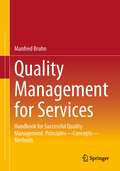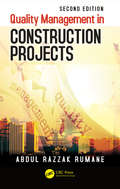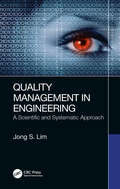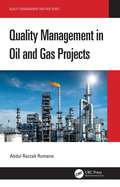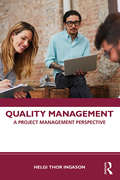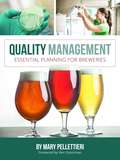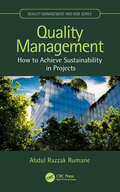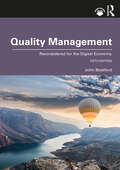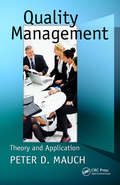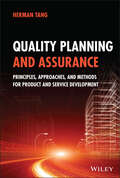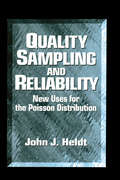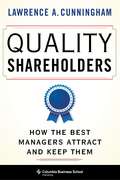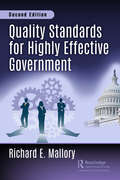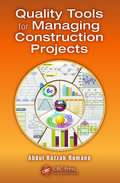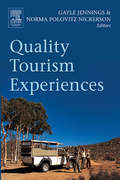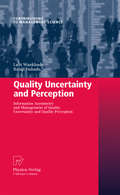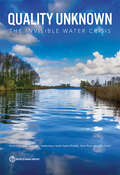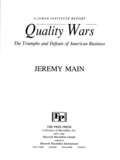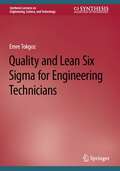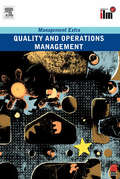- Table View
- List View
Quality Management for Services: Handbook for Successful Quality Management. Principles – Concepts – Methods
by Manfred BruhnThis book provides assistance for ensuring and increasing service quality. Manfred Bruhn presents a holistic, scientifically based approach to quality management for services, which is consistently oriented to the management process with the phases of analysis, planning, control and monitoring of quality management. Core parts of the book are procedures for measuring service quality, instruments for controlling quality and expectation management, the implementation of quality management based on ISO 9000 ff. standards as well as the EFQM model, and comprehensive quality controlling to ensure effectiveness and efficiency.In the eleven editions to date, the work has evolved into a handbook and can be used as a reference work for the various topics of quality management for services. Individual topics of quality management or the respective chapters can be worked through independently of each other.In the 12th edition, all chapters have been updated. In particular, the new version of the EFQM Model 2020 has been comprehensively presented.The contentsBasics of quality management for servicesAnalysis of service qualityPlanning and control of quality management for servicesImplementation of quality management for servicesQuality controlling for services
Quality Management in Construction Projects (Systems Innovation Book Series)
by Abdul Razzak RumaneThe first edition published in 2010. The response was encouraging and many people appreciated a book that was dedicated to quality management in construction projects. <P><P>Since it published, ISO 9000: 2008 has been revised and ISO 9000: 2015 has published. The new edition will focus on risk-based thinking which must be considered from the beginning and throughout the project life cycle. <P><P>There are quality-related topics such as Customer Relationship, Supplier Management, Risk Management, Quality Audits, Tools for Construction Projects, and Quality Management that were not covered in the first edition. Furthermore, some figures and tables needed to be updated to make the book more comprehensive.
Quality Management in Engineering: A Scientific and Systematic Approach
by Jong S. LimThis book introduces fundamental, advanced, and future-oriented scientific quality management methods for the engineering and manufacturing industries. It presents new knowledge and experiences in the manufacturing industry with real world case studies. It introduces Quality 4.0 with Industry 4.0, including quality engineering tools for software quality and offers lean quality management methods for lean manufacturing. It also bridges the gap between quality management and quality engineering, and offers a scientific methodology for problem solving and prevention. The methods, techniques, templates, and processes introduced in this book can be utilized in various areas in industry, from product engineering to manufacturing and shop floor management. This book will be of interest to manufacturing industry leaders and managers, who do not require in-depth engineering knowledge. It will also be helpful to engineers in design and suppliers in management and manufacturing, all who have daily concerns with project and quality management. Students in business and engineering programs may also find this book useful as they prepare for careers in the engineering and manufacturing industries. Presents new knowledge and experiences in the manufacturing industry with real world case studies Introduces quality engineering methods for software development Introduces Quality 4.0 with Industry 4.0 Offers lean quality management methods for lean manufacturing Bridges the gap between quality management methods and quality engineering Provides scientific methodology for product planning, problem solving and prevention management Includes forms, templates, and tools that can be used conveniently in the field
Quality Management in Oil and Gas Projects (Quality Management and Risk Series)
by Abdul Razzak RumaneThis book provides the tools and techniques, management principles, procedures, concepts, and methods to ensure the successful completion of an oil and gas project while also ensuring the proper design, procurement, and construction for making the project most qualitative, competitive, and economical for safer operational optimized performance. It discusses quality during design, FEED, detailed engineering, selection of project teams, procurement procedure of EPC contract, managing quality during mobilization, procurement, execution, planning, scheduling, monitoring, control, quality, and testing to achieve the desired results for an oil and gas project. This book provides all the related information to professional practitioners, designers, consultants, contractors, quality managers, project managers, construction managers, and academics/instructors involved in oil and gas projects and related industries. Features Provides information on the various quality tools used to manage construction projects from inception to handover Discusses the life cycle phases, developed on systems engineering approach, and how it is divided into manageable activity/element/components segments to manage and control the project Includes a wide range of tools, techniques, principles, and procedures used to address quality management Covers quality management systems and development of quality management systems manuals Discusses quality and risk management, and health, safety, and environmental management during the design and construction process
Quality Management in Reverse Logistics
by Yiannis NikolaidisQuality Management in Reverse Logistics intends to develop, collect, examine and evaluate a number of quality management (QM) tools and techniques, which can be applied in practice in order to understand, review and improve any closed-loop supply chain process. In other words, the book aims to examine the existing relationship between various well-developed and thoroughly studied quality issues, such as QM, quality assurance, standardization of processes and statistical quality control and the emerging research area of reverse logistics. Quality Management in Reverse Logistics contains modeling and quantitative methods that could be used by practitioners and academics in the reverse logistics industry, as well as a thorough description of QM tools and techniques. The book leads the potential reader to broaden their scope of thinking and acting in the new, promising area of reverse logistics, where QM can be applied.
Quality Management, Value Creation, and the Digital Economy (Routledge Advances in Production and Operations Management)
by Muhammad Shahbaz Justyna Żywiołek Joanna Rosak-SzyrockaIn the conditions of the modern market economy, in which globalization and competition are rife, quality is of great importance for determining a company's position in the market. The changing and complex economic reality is shaping new market patterns while modern technologies influence purchasing decisions. This book presents an effective and novel framework for creating value in Industry 4.0 conditions by building a smart enterprise model using quality management theories. The book explores tools and platforms that can be utilized to contribute to the creation of the ideal quality for demanding customers, using case studies from international contributors. It proposes novel architectures that drive economically viable production and services businesses, addressing unique Industry 4.0 and 5.0 solutions in Internet of Things (IoT) that involve the entire spectrum of analysis, with a special focus on lean methodologies and cybersecurity. This original book will be valuable reading for researchers and scholars in the areas of quality management, manufacturing, production, and operations management.
Quality Management: A Project Management Perspective
by Helgi Thor IngasonThe implementation of quality management can be seen as a sequence of projects and evolves as a result of how projects are planned, executed and closed. This book explores quality management from a project management perspective, based on the author’s long experience of teaching and practicing, including the implementation and operation of quality management systems within various types of organisations. The author explores the origins of quality management as a discipline, it’s appearance in the present form and how quality management can be implemented and applied in all kinds of organisations to achieve stability and better results. The basic principles of quality management and the ISO9001 quality management standard are discussed and explained from a broad perspective, with illustrative examples from different types of organisations. Quality Management offers a global, accessible guide for undergraduate and postgraduate university students. Written clearly and with illustrative examples, it will also appeal to all those interested in project management and quality management and wishing to expand their knowledge base.
Quality Management: Essential Planning for Breweries
by Mary PellettieriQuality management for small, regional, and national breweries is critical for the success of craft brewing businesses. Written for staff who manage quality assurance (QA) and quality control (QC) in breweries of all sizes, this book clearly sets out how quality management is integrated into every level of operation.Author Mary Pellettieri shows how quality management is a concept that encompasses not only the &“free from defect&” ethos but combines the wants of the consumer and the art of brewing good beer. Breweries must foster a culture of quality, where governance and management seamlessly merge policy, strategy, specifications, goals, and implementation to execute a QA/QC program. What tests are necessary, knowing that food safety alone does not signify a quality product, adhering to good management practice (GMP), proper care and maintenance of assets, standard operating procedures, training and investment in staff, and more must be considered together if a quality culture is to translate into success.The people working at a brewery are the heart of any quality program. Management must communicate clearly the need for quality management, delineate roles and responsibilities, and properly train and assess staff members. Specialist resources such as a brewery laboratory are necessary if an owner wants to be serious about developing standard methods of analysis to maintain true-to-brand specifications and ensure problems are identified before product quality suffers. Staff must know the importance of taking corrective action and have the confidence to make the decision and implement it in a timely fashion. With so many processes and moving parts, a structured problem-solving program is a key part of any brewery's quality program.How should you structure your brewing lab so it can grow with your business? What chemical and microbiological tests are appropriate and effective? How are new brands incorporated into production? How do you build a sensory panel that stays alert to potential drifts in brand quality? Which FDA and TTB regulations affect your brewery in terms of traceability and GMP? Can you conduct and pass an audit of your processes and products? Mary Pellettieri provides answers to these key organizational, logistical, and regulatory considerations.
Quality Management: How to Achieve Sustainability in Projects (Quality Management and Risk Series)
by Abdul Razzak RumaneDivided into four main chapters, this book covers the inception on through to the handover of a project and details the three main stages (study stage, design stage, and construction stage) involved with managing any type of project. The book discusses the sustainability framework and provides an overview of quality management with construction projects along with the most common quality tools used to manage quality and achieve sustainability in projects. Quality Management: How to Achieve Sustainability in Projects takes the reader from start to finish with a focus on the sustainability elements needed to manage quality in projects and details the application of sustainability principles at different stages. The book discusses the quality tools used in managing sustainability and provides concise and complete information on how to easily achieve it through to the project handover stage. The book is written for Project Management professionals such as Project Managers, Quality Managers, Industrial Engineers, and Construction Managers, as well as Design Management professionals, academics, trainers, and graduate students.
Quality Management: Reconsidered for the Digital Economy
by John BeckfordQuality Management: Reconsidered for the Digital Economy continues to provide a one-stop-shop for anyone studying the theory and practice of quality management. Exploring the essentials of management theory and the work of the ‘quality gurus’ who have formed the foundation of current practice, this new edition builds upon the previous editions’ unique critical perspective of quality. Key management practices are considered and extended, including lean thinking, systems methodologies, business process reengineering, organisational learning and intelligent organisations and service quality management. This edition plays particularly close attention throughout to the impact of the 4th Industrial Revolution on quality management, revisiting the meaning of ‘quality’ in an automated and data-driven world. Throughout, case studies have been rewritten including new examples from emerging economies, and practical tools incorporated to enhance learning and application. Replete with examples, vignettes and diagrams, this comprehensive textbook is ideal for those new to the field of quality management and for students on advanced undergraduate and postgraduate courses in Operations Management. Online resources include chapter-by-chapter PowerPoint slides and a test bank of questions.
Quality Management: Theory and Application
by Peter D. MauchIn the past, when goods and services were simpler, measurement of quality was self-evident. As business became more complicated, so too did the implementation of quality management and our ability to measure it. Ultimately, the practice of quality strayed from being a business practice to become much more of an engineering discipline producing plen
Quality Planning and Assurance: Principles, Approaches, and Methods for Product and Service Development
by Herman TangQUALITY PLANNING AND ASSURANCE Discover the most crucial aspects of quality systems planning critical to manufacturing and service success In Quality Planning and Assurance: Principles, Approaches, and Methods for Product and Service Development, accomplished engineer Dr. Herman Tang delivers an incisive presentation of the principles of quality systems planning. The book begins with an introduction to the meaning of the word “quality” before moving on to review the principles of quality strategy and policy management. The author then offers a detailed discussion of customer needs and the corresponding quality planning tasks in design phases, as well as a treatment of the design processes necessary to ensure product or service quality. Readers will enjoy explorations of advanced topics related to proactive approaches to quality management, like failure modes and effects analysis (FMEA). They???ll discover discussions of issues like supplier quality management and the key processes associated with quality planning and execution. The book also includes: A thorough introduction to quality planning, including definitions, discussions of quality system, and an overview of the planning process A comprehensive exploration of strategic planning development, including strategic management, risk management and analysis, and pull and push strategies Practical discussions of customer-centric planning, including customer-oriented design, quality function deployment, and affective engineering In-depth examinations of quality assurance by design, including the design review process, design verification and validation, and concurrent engineering Perfect for senior undergraduate and graduate students in technology and management programs, Quality Planning and Assurance will also earn a place in the libraries of managers and technical specialists in a wide range of fields, including quality management.
Quality Sampling and Reliability: New Uses for the Poisson Distribution
by John J HeldtAs a mathematical model for determining the probable number of outcomes, the new Poisson Distribution tables have long been an easier tool to use for reliability analyses. Longtime quality professional, inventor, and consultant John J. Heldt now makes the Poisson Table even more useful-creating two new tables (available only in this book) with the Poisson terms rearranged for further ease of estimation.Quality Sampling and Reliability: New Uses for the Poisson Distribution simplifies the steps involved with reliability testing; Mean Time Between Failure (MTBF) assessment; advantages and risks involved in reliability life testing; and an example of methodology for tracking the MTBF for products in the field.In addition to the tried-and-true Standard Poisson table, used to review conventional Poisson uses, Heldt's two variations yield these results: Estimations of product Mean Time Between Failures (MTBFs), based on life tests-including the 90%, 80% or 60% envelop for any MTBFs that have been derivedDevelopment of the Operating Characteristic Curves for Life testing-showing the risks and advantages of any test used to assure the product MTBF is not varying in a detrimental mannerWritten for easy comprehension, with numerous illustrations, Quality Sampling and Reliability: New Uses for the Poisson Distribution will help quality professionals, engineers, instructors and students alike in their reliability testing tasks.
Quality Service Management: A Guide to Improving Business Processes
by John MaleyeffProviding clear guidance for anyone servicing internal or external customers, this book offers a framework for analyzing and managing quality using a comprehensive closed-loop approach. This book cuts through the complexities of the mantra ‘better, cheaper, faster’ (BCF) and offers procedures for the evaluation of customer needs, the determination of performance metrics, and the design of effective customer satisfaction surveys. It details basic statistical techniques and packages the framework, procedures, and methods into a management construct that includes external quality certification systems and internal performance management systems. Importantly, the book also describes how these systems can be implemented in a virtual workplace. This quality management book will be essential to service-oriented firms (financial, government, healthcare, hospitality, etc.), as well as any firm with internal customer service processes such as human resource management, purchasing, and accounting. Professionals at all levels, corporate trainers, and students will welcome this book’s common set of principles and tools, accompanied by many case studies that illustrate how they are applied in various environments.
Quality Shareholders: How the Best Managers Attract and Keep Them
by Lawrence CunninghamAnyone can buy stock in a public company, but not all shareholders are equally committed to a company’s long-term success. In an increasingly fragmented financial world, shareholders’ attitudes toward the companies in which they invest vary widely, from time horizon to conviction. Faced with indexers, short-term traders, and activists, it is more important than ever for businesses to ensure that their shareholders are dedicated to their missions. Today’s companies need “quality shareholders,” as Warren Buffett called those who “load up and stick around,” or buy large stakes and hold for long periods.Lawrence A. Cunningham offers an expert guide to the benefits of attracting and keeping quality shareholders. He demonstrates that a high density of dedicated long-term shareholders results in numerous comparative and competitive advantages for companies and their managers, including a longer runway to execute business strategy and a loyal cohort against adversity. Cunningham explores dozens of corporate practices and policies—such as rational capital allocation, long-term performance metrics, and a shareholder orientation—that can help shape the shareholder base and bring in committed owners. Focusing on the benefits for corporations and their investors, he reveals what draws quality shareholders to certain companies and what it means to have them in an investor base. This book is vital reading for investors, executives, and directors seeking to understand and attract the kind of shareholders that their companies need.
Quality Standards for Highly Effective Government: Second Edition
by Richard Mr MalloryA seminal work for the public sector, Quality Standards for Highly Effective Government (Second Edition) redefines what is expected and what is required for excellence in management. The practices presented here also benefit non-profit organizations, and indeed any organization in which services are not directly rewarded by a purchase transaction. The book introduces three new performance standards that frame the value add of management, for processes, systems, and aligned leadership objectives. Along with defining known best practices, these standards create an imperative for the use of Lean and continuous quality improvement as a foundation for good management, built onto that defined structure. These standards also create a means to recognize and reward those managers who build and regularly use this framework. Measurable quality standards are necessary for government, because there is no free market incentivizing government managers for efficiency, and there is no direct penalty for offices that provide poor service. The oversight of government is left to elected officials, who often only get generalized and high level feedback and then only on failure. Where there is failure, the usual response of leadership is to change leadership or to restructure offices. But these actions never get to the level of the workers on the ground, and cannot change whether they have or are currently using best practice modeling. Richard Mallory both defines and shows the logic behind the process management standard, the system management standard, and the aligned leadership objectives standard, and how these apply to front line managers, program and executive managers, and even to elected leaders. Because these standards are measurable and auditable, they can form the basis of an integrated scorecard for every government agency in the world, and a roadmap on how to obtain maximum value from each of them. The credibility of these standards is underwritten and proven through their adoption by the Government Division of the American Society for Quality, and international best practice standards for governments worldwide.
Quality Standards, Value Chains, and International Development
by Johan SwinnenOver the past decades, the world has witnessed an unprecedented growth in global value chains, propelled by increasingly demanding quality standards. These trends lead to concerns about the impact of value chains on development and poverty and about the possible protectionist nature of quality standards in rich countries. This book offers the first integrated theoretical analysis of the economic and political factors which determine the level of quality standards, as well as their economic effects along the value chain. Using realistic assumptions motivated by empirical research, the theoretical framework in this book makes it possible to study the efficiency effects as well as the distributional consequences of one of the most striking evolutions affecting global trade and development today.
Quality Tools for Managing Construction Projects (Systems Innovation Book Series)
by Abdul Razzak RumaneDealing with such a multi-layered and fungible intangible as quality during the design and construction process is difficult for all parties involved. To the architect, quality means an appealing and enduring design, but to the builder, it means understandable documents that, when acted upon, lead to an enduring, well-made structure. To the owner,
Quality Tourism Experiences
by Gayle Jennings Norma Polovitz NickersonThe theme of the edited book acknowledges the multiple meanings of quality tourism experiences, the diverse contexts in which tourism occurs, and the varied stakeholders associated directly or indirectly with the phenomenon of tourism."Quality tourism experiences" is a widely used phrase in tourism and tourism-related texts and is associated with a diversity of meanings and usage. Meanings are ascribed by industry/business, government agencies, tourists, community and academics. The phrase is used to argue, for example, for positive social impacts, economic benefits, environmental protection, government policy formulation, discrimination between tourism products as well as issues associated with sustainability. Subsequently, the phrase "quality tourism experiences" is not a nomothetic term but rather one associated with multiple interpretations and meanings. The book"s overarching tenet is that "quality" is a socially constructed term (as are the terms tourism experiences). Authors investigate the role of the mass media, the role of travel providers, the role of host communities, the role of tourists, and the role of "government" at all its levels. From an academic perspective, quality tourism experiences are associated with interaction between host and guest (tourists and community perspectives), the classification of type of tourism product (tourism industry and government sector perspectives), market differentiation and development, tourist perspectives, the notion of an integrated system and benefits from an economic perspective.Similarly, quality is associated with different meanings and is used in a variety of contexts within tourism literature. For example quality is associated with service quality, quality assurance/auditing and control, perceptions of quality at an individual/business/community level, that is, stakeholder level, and in regard to product and market differentiation. The book draws together writers from different backgrounds and interdisciplinary interests and research methodologies, as a consequence, the book provides a model of the way researchers can work together to illuminate an area and to provide multiple representations and interpretations of that area. Moreover the book demonstrates interdisciplinary, transdisciplinary and intradisciplinary approaches and collaborations.Kathleen Andereck, Ph.D., Arizona State University WestSue Beeton, Ph.D., La Trobe UniversityHeather E. Bowen, Ph.D., George Mason UniversityKelly S. Bricker, Ph.D., West Virginia University Barbara Carmichael, Ph.D., Wilfrid Laurier UniversityMaggie Daniels, Ph.D., George Mason UniversityGayle Jennings, Ph.D., Central Queensland UniversityClaudia Jurowski, Ph.D, Northern Arizona UniversityDeborah Kerstetter, Ph.D., Penn State UniversityNorma Nickerson, Ph.D., University of MontanaLori Pennington-Gray, Ph.D., University of Florida Carla Almeida Santos, Ph.D., University of Illinois at Urbana-Champaign Betty Weiler, Ph.D., Monash University
Quality Uncertainty and Perception
by Lalit Wankhade Balaji DabadeThe book addresses the complex issue of quality uncertainty due to information asymmetry in the backdrop of information economics, total quality management and marketing science. Reliability Engineering, Seven Management Tools and System Dynamics are used to develop theories on quality uncertainty and perception. Quality perception is identified as a multidisciplinary measure of business performance. The tools are developed to minimize quality uncertainty or to maximize quality perception. A few worksheets are provided for applying these theories to improve business performance.
Quality Unknown: The Invisible Water Crisis
by Richard Damania Sébastien Desbureaux Aude-Sophie Rodella RussWater quantity—too much in the case of floods, or too little in the case of droughts—grabs public attention and the media spotlight. Water quality—being predominantly invisible and hard to detect—goes largely unnoticed. Quality Unknown: The Invisible Water Crisis presents new evidence and new data that call urgent attention to the hidden dangers lying beneath water’s surface. It shows how poor water quality stalls economic progress, stymies human potential, and reduces food production. Quality Unknown examines the effects of water quality on economic growth and finds upstream pollution lowers growth in downstream regions. It reveals that some of the most ubiquitous contaminants in water, such as nitrates and salt, have impacts that are larger, deeper, and wider than has been acknowledged. And it traces the damage to crop yields and the stark implications for food security in affected regions. An important step toward tackling the world’s water quality challenge is recognizing its scale. The world needs reliable, accurate, and comprehensive information so that policy makers can have new insights, decision making can be evidence based, and citizens can call for action. The report calls for a paradigm shift that emphasizes safer, and often more cost-effective remedies that prevent pollution by combining smarter policies with newer technologies. A key message of Quality Unknown is that such solutions exist and change is possible.
Quality Wars: The Triumphs and Defeats of American Business
by Jeremy MainThe quality revolution in American industry, now more than a decade old, has produced an avalanche of books, but this is the first in-depth study reporting the struggles from inside the companies that have attempted large-scale improvement efforts. Jeremy Main has interviewed more than a dozen chief executives, all of whom have managed quality programs, including Charles Clough of Nashua, Robert Galvin of Motorola, James Hagen of Conrail, Roger Milliken of Milliken, Ray State of Analog Devices, and John Young of Hewlett-Packard, in addition to hundreds of other senior executives, workers, labor representatives, city officials, military officers, and hospital administrators. Through their experiences, Main reveals what works and what doesn't work when an organization attempts the transforming leap into Total Quality Management. Their message comes through loud and clear: it is a tough battle, but persistence can win priceless rewards. The notable successes at BancOne, L.L. Bean, Ford, Hewlett-Packard, Motorola, Saturn, Solectron, and Xerox prove it. However, Main shows that Motorola and Hewlett-Packard, among the earliest and best practitioners of total quality, are still finding obstacles to overcome. And some other early converts, such as Florida Power & Light, have stumbled badly along the way. Main's vivid descriptions of these setbacks capture the difficulties inherent in implementing a total quality system. His dramatic accounts of success and failure at companies such as Milliken and Intel convey valuable knowledge that is otherwise gained only by actual experience. The way to achieve the "new quality" of today, Main shows, is through a full commitment to TQM. He reveals through the experiences of these companies that TQM is not just a management tool, as it has often been used, but a management philosophy that is indispensable in attaining a high level of quality -- now a requisite for competing successfully. With the collaboration of the Juran Institute, Main demonstrates how TQM has transformed companies by improving quality at all levels. The accounts of these triumphs are direct evidence that world-class quality is attainable by American industry, and will inspire and point the way for executives, managers, and government officials in their timeless pursuit of total quality.
Quality and Lean Six Sigma for Engineering Technicians (Synthesis Lectures on Engineering, Science, and Technology)
by Emre TokgozThis textbook is the first of its kind, designed exclusively for the training and professional development of engineering technicians and technologists on the quality concepts, tools, and skills necessary for today's industrial environment. The book provides learners and working professionals with numerous examples, exercises, and case studies to prepare them to apply concepts including total quality management (TQM), six sigma, and lean methodology in analyzing and solving quality problems and implementing process improvements and corrective actions in the manufacturing process.Quality and Lean Six Sigma for Engineering Technicians gives readers a practical understanding of six sigma and manufacturing improvement concepts. It is also a go-to reference for practicing engineering technicians already working in the field.
Quality and Legitimacy of Global Governance
by Timothy CadmanSince the Rio 'Earth' Summit of 1992, sustainable development has become the major policy framework through which the international community deals with pressing environmental issues such as deforestation. Implicit in this approach is the belief that the market provides the best mechanism to bring government, business and society together, and a whole plethora of market-driven schemes have been developed in response. Yet how legitimate are these institutions, and where is their democratic accountability? This book looks at four institutions created to address forest management, namely the Forest Stewardship Council (non-governmental), the Programme for the Endorsement of Forest Certification (business), the ISO 14000 Series of environmental standards (technocratic), and the United Nations Forum on Forests (governmental). It finds large discrepancies in the approaches taken, and the degree to which the four systems provide for meaningful participation and productive deliberation amongst stakeholders trying to address the global forest crisis.
Quality and Operations Management Revised Edition: Revised Edition (Management Extra Ser.)
by ElearnManagement Extra brings all the best management thinking together in one package. The series fuses key ideas with applied activities to help managers examine and improve how they work in practice. Management Extra is an exciting, new approach to management development. The books provide the basis for self-paced learning at level 4/5. The flexible learning structure allows busy participants to study at their own convenience, minimising time away from the job. The programme allows trainers to quickly plan and deliver high quality, business-led courses. Trainers can select materials to meet the needs of their delegates, clients, and budget. Each book is divided into themes of ideal length for delivering in a training session. Each theme has a range of activities for delegates to complete, putting the training into context and relating it to their own situation and business. The books’ lively style will stimulate further interest in the subjects covered. Guides for further reading and valuable web references provide a lead-in to further research. Management Extra is based on the NVQ framework to ease the creation of Diploma, Post Graduate Diploma or NVQ programmes for managers. It is accredited with all leading awarding bodies.
